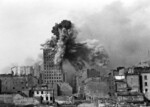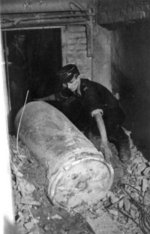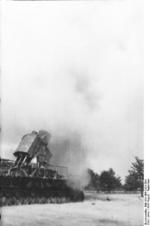Karl-Gerät
| Country | Germany |
| Manufacturer | Rheinmetall AG |
| Primary Role | Self-Propelled Gun |
Contributor: C. Peter Chen
ww2dbaseIn Mar 1936, German manufacturing firm Rheinmetall AG began to work on a super-heavy howitzer for attacking the French defensive Maginot Line. Initially, the idea was to build a large caliber weapon that was to be transported in pieces and assembled near the front, however the time needed to assemble such a weapon made the proposal inadequate, thus by Jan 1937 the plan had changed for the design to be self-propelled. Firing trials took place in Jun 1939, and driving trials were in May 1940. Because General Karl Becker of the German Army was deeply involved with the development, the design eventually bore his name, Karl-Gerät. Between Nov 1940 and Aug 1941, seven Karl-Gerät howitzers were built; they were nicknamed Adam, Eva, Thor, Odin, Loki, and Ziu (the seventh had no nickname). 22 Panzer IV tanks were especially converted to each carry four shells for these large-caliber howitzers. They were still mostly transported in pieces as originally thought, mainly for speed concerns, but their Daimler-Benz engines also offered a 10 kilometers-per-hour speed for front-lines maneuvering and aiming.
ww2dbaseKarl-Gerät self-propelled howitzers were first used against the defenses at Brest, Belarus in Aug 1941. In Jun and Jul 1942, three of them fired on the Russian city of Sevastopol, causing devastation to concrete bunkers. For the following two years, they were, more than once, ordered to assist in the siege of Leningrad, Russia, but each time the plans were canceled. On 13 Aug 1944, a battery was created with Karl-Gerät self-propelled howitzer number 6, "Ziu", to be attached to the German 9th Army and to be assigned to counter the Warsaw Uprising in Poland. "Ziu" arrived at the Warsaw West train station at 0700 hours on 17 Aug 1944, but the train containing its ammunition did not arrive until the following day. Through the following 30 days, three more Karl-Gerät self-propelled howitzers arrived at Warsaw, bombarding Polish insurgent positions from outside the city. In Dec 1944, at least one of them participated in the Battle of the Bulge.
ww2dbaseAs the European War neared its end, Number 2 "Eva", Number 5 "Loki", and Number 7 were captured by the Americans between 21 Mar and 11 Apr 1945; Number 7 was shipped to the Aberdeen Proving Grounds in Maryland, United States for evaluation, and it was later scrapped. Number 6 "Ziu" was captured by the Russians on or about 20 Apr 1945 near Jüterbog, Germany; it is now on display at the Kubinka Tank Museum in Russia. Number 1 "Adam" and Number 3 "Thor" were likely to be captured by the Russians as their last known location was in Jüterbog.
ww2dbaseSource: Wikipedia.
Last Major Revision: Oct 2009
SPECIFICATIONS
Number 1 'Adam'
| Machinery | One Daimler-Benz MB 503 A 12-cylinder gasoline engine rated at 580hp |
| Suspension | Torsion bar |
| Armament | 1x54cm L/11.55 howitzer |
| Crew | 21 |
| Length | 11.15 m |
| Width | 3.16 m |
| Height | 4.38 m |
| Weight | 126.4 t |
| Speed | 10 km/h |
| Range | 42 km |
Number 2 'Eva'
| Machinery | One Daimler-Benz MB 503 A 12-cylinder gasoline engine rated at 580hp |
| Suspension | Torsion bar |
| Armament | 1x60cm howitzer |
| Crew | 21 |
| Length | 11.15 m |
| Width | 3.16 m |
| Height | 4.38 m |
| Weight | 126.4 t |
| Speed | 10 km/h |
| Range | 42 km |
Number 3 'Thor'
| Machinery | One Daimler-Benz MB 507 C 12-cylinder diesel engine rated at 580hp |
| Suspension | Torsion bar |
| Armament | 1x60cm howitzer |
| Crew | 21 |
| Length | 11.15 m |
| Width | 3.16 m |
| Height | 4.38 m |
| Speed | 6 km/h |
| Range | 60 km |
Number 4 'Odin'
| Machinery | One Daimler-Benz MB 507 C 12-cylinder diesel engine rated at 580hp |
| Suspension | Torsion bar |
| Armament | 1x54cm L/11.55 howitzer |
| Crew | 21 |
| Length | 11.15 m |
| Width | 3.16 m |
| Height | 4.38 m |
| Weight | 126.4 t |
| Speed | 6 km/h |
| Range | 60 km |
Number 5 'Loki'
| Machinery | One Daimler-Benz MB 507 C 12-cylinder diesel engine rated at 580hp |
| Suspension | Torsion bar |
| Armament | 1x54cm L/11.55 howitzer |
| Crew | 21 |
| Length | 11.15 m |
| Width | 3.16 m |
| Height | 4.38 m |
| Weight | 126.4 t |
| Speed | 6 km/h |
| Range | 60 km |
Number 6 'Ziu'
| Machinery | One Daimler-Benz MB 503 A 12-cylinder gasoline engine rated at 580hp |
| Suspension | Torsion bar |
| Armament | 1x60cm howitzer |
| Crew | 21 |
| Length | 11.15 m |
| Width | 3.16 m |
| Height | 4.38 m |
| Weight | 126.4 t |
| Speed | 6 km/h |
| Range | 42 km |
Number 7
| Machinery | One Daimler-Benz MB 503 A 12-cylinder gasoline engine rated at 580hp |
| Suspension | Torsion bar |
| Armament | 1x60cm howitzer |
| Crew | 21 |
| Length | 11.15 m |
| Width | 3.16 m |
| Height | 4.38 m |
| Weight | 126.4 t |
| Speed | 6 km/h |
| Range | 42 km |
Photographs
 |  |  |  |
Please consider supporting us on Patreon. Even $1 per month will go a long way! Thank you. Please help us spread the word: Stay updated with WW2DB: |
Visitor Submitted Comments
4 Nov 2009 04:22:05 PM
The manpower needed besides the firing crew
necessary to maintain, move, supply and
defend the weapon,was just enormous.
The men needed: You needed the Artillerymen, different crews to fire and handle the huge
rounds and power-bags,Communications to link
all field telephones under Command and
Control and the Fire Control Section, Supply
order and issue all necessary cleaning supplies, tools, spare parts for all wheeled and tracked vehicles.The mechanics to service
all vehicles. Crews to dispose of all un-used
power bags, Medical personnel, Cooks and unit
orderly messengers, Infantry and flak gun crews to protect the weapon. This detachment could be about 1,500 men, not covering some units assigned during operations and under command of a General.
Anyway,this is my guess knowing most armies operate this way, except today their are no railway guns, just conventual artillery.
All visitor submitted comments are opinions of those making the submissions and do not reflect views of WW2DB.

- » Wreck of Teruzuki Found (27 Jul 2025)
- » USS Orlean's Bow Found (22 Jul 2025)
- » The Emperor of Japan Planned to Honor WW2-era Japanese POWs in Mongolia (4 Jul 2025)
- » US State Lawmaker John Winter Caught Using Racial Slur "Jap" and Apologized (11 Jun 2025)
- » US Government Plans to Purge WW2 Information (17 Mar 2025)
- » See all news
- » 1,182 biographies
- » 337 events
- » 45,131 timeline entries
- » 1,249 ships
- » 350 aircraft models
- » 207 vehicle models
- » 376 weapon models
- » 123 historical documents
- » 261 facilities
- » 471 book reviews
- » 28,431 photos
- » 365 maps
General Douglas MacArthur at Leyte, 17 Oct 1944
Please consider supporting us on Patreon. Even $1 a month will go a long way. Thank you!
Or, please support us by purchasing some WW2DB merchandise at TeeSpring, Thank you!
1 Nov 2009 03:40:54 PM
The Karl series weapons were produced during
the 1930's. Work on the actual hardware began
during 1937,and the first guns ready by 1939
The Karl Gerat 040/60cm mortar was the
largest self-propelled weapon ever built.
It could fire high explosive shells that were
2.5 meters long and weighed 4,800lbs. 6.7 miles and created a crater over 50ft wide! Rate of fire 6 rph (rounds per hour). Barrel life was 60 rounds six production weapons were built.
Ammunition was transported in special tracked
Munitionsschlepper's converted from the
PzKpfw IV each vehicle carried four rounds. The crew was over 1,400 men,and was commanded
by a Major General.
The Railway version 041/54cm Karl Gerat fired
the same high explosive ammunition that was 2.5 meters long and weighted 4,800lbs. range
was 10.4 miles with same rate of fire 6 rph
(rounds per hour) a slow rate of fire about
one round every 10 minutes.
Ammunition was carried by PzKpfw IV's, that
carried four rounds. Barrel life was the same 60 rounds. Both of these Karl weapons were massive and ponderous brutes alot of
time and effort went into servicing these weapons technically they were self-propelled
however,their mobility was limited.
For long-distance travel they were carried
slung between specially designed railway cars
Shorter trips the weapons were broken-down
and carried on special trailers.
Assembly was within range of the target.
The whole process was difficult, but the Karl
weapons were not designed for mobile warfare.
The massive Karl's were really fortification
smashing weapons, and they had only limited
tactical mobility.
They had to be carried to the firing position
by special trailers in sections and then
assembled on site within range of the target.
During the last days of W.W.II most were
destroyed by their crews. Only a few of the
PzKpfw IV ammunition carriers survived.
One weapon may survive in Russia,as a museum
piece.
What is a Mortar:
A muzzle loading weapon for indirect fire
with either a rifled or smooth bore. It has
a shorter range then a howitzer, and a high angle of fire between 45 and 90 degrees.